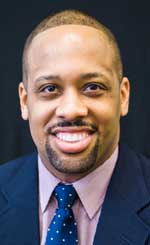Learning through a multidisciplinary lens
ON ROTATION
The classroom didactic portion of pharmacy school education is essential for the development of foundational pharmacy knowledge. However, in our opinion, time spent in the classroom exclusively can limit the growth and maturation of students in other areas.
Our (Robbie and Luke) recent experiences with coordinated activities based in the community provided us with background on how to best maximize clinical rotations and learning
opportunities outside the classroom.
Limits of classroom learning
In most school environments, there is a set schedule provided by different syllabi. Going to lectures and cramming for tests can become the norm. Learning in the same environment from a consistent set of professors can be exhausting for some, potentially yielding diminished returns. As a result, students can become disillusioned into thinking life will always present information to them packaged neatly in PowerPoint presentation formats.
Another constraint of learning in the classroom is the customary exchange of information. The lingering fear of failing examinations may force
students to cram and use short-term memorization techniques rather than actually seek to learn and understand the material. In addition, it is very common to have several consecutive classes in 1 day, enabling large amounts of material covering different subjects to bombard students all at once. This method of educational interchange may limit the depth of conversations that class attendees could potentially have while promoting passive learning.
So we advocate for making a shift in education to include more outside class activities to help students reach their full potential.
Diversity of learning
Augmenting the traditional classroom settings along with APPEs represents maximization of students’ educational experiences. Throughout pharmacy school, learning often reflects a predetermined curriculum. Conversely, on experiential rotations, the responsibility for embracing uninhibited learning falls on APPE students. Many preceptors already have established connections within the community and can act as a mentor; sometimes it just takes APPE students to ask, “What outside learning opportunities are available?”
APPE rotations during our final year in Columbia, SC, provided opportunities to participate in several meetings, conferences, workshops, dinners, etc. By attending off-site educational opportunities, there was exposure to the diversifications of learning. New ways of learning were established. The various locations and venues enhanced the ability to focus and increased the enjoyment of the topics being discussed.
Community learning activities
Ongoing structured learning from different health professionals external to core APPE responsibilities has many advantages. Operationally, APPE students provide therapeutic insights to participants and workshop facilitators in attendance. For example, HIV 101 and HIV 201 training courses offered by the South Carolina Department of Health and Environmental Control provide general overviews of disease transmission and epidemiological trends. The specifics of drug regimens are briefly presented among the different course offerings. Student pharmacists are therefore able to elaborate upon key medication tenets in a value-added capacity. In the absence of APPE students at these sessions, typically a lack of pharmacy perspective would exist. From a networking vantage point, these educational platforms help APPE students to foster ongoing relationships with professionals from a variety of disciplines.
In addition, awareness of diverse practice settings provides opportunities for APPE students to solidify areas of interests and disinterests as they transition into their careers. Predicated upon employment compatibilities, these sessions may serve as de facto interviews for APPE students with individuals they encounter who possess hiring authority. Walgreens has regularly collaborated with our school to promote awareness of the approved medication for HIV pre-exposure prophylaxis (PrEP). These informational events housed within various Walgreens locations allow students to demonstrate competence and confidence when interacting with patients about HIV PrEP. These initiatives also allow Walgreens personnel to assess the levels of engagement students exude to assist them in making projections as to whether or not the demonstrated abilities could translate into full-time employment.
These activities introduce students to diverse topics that perhaps the constraints of the pharmacy curriculum are unable to address. Nevertheless, these versatile instructional pearls are quite valuable to the careers of future pharmacists.



